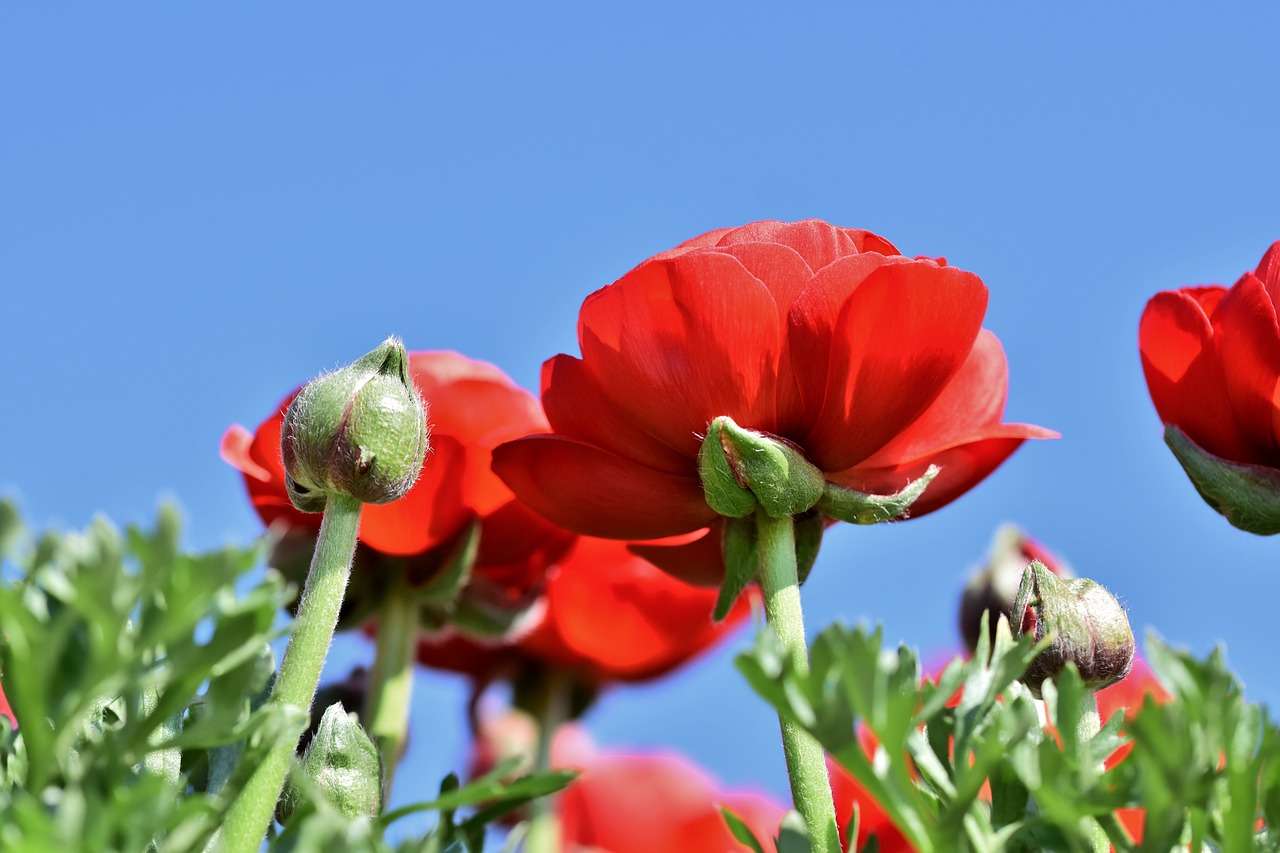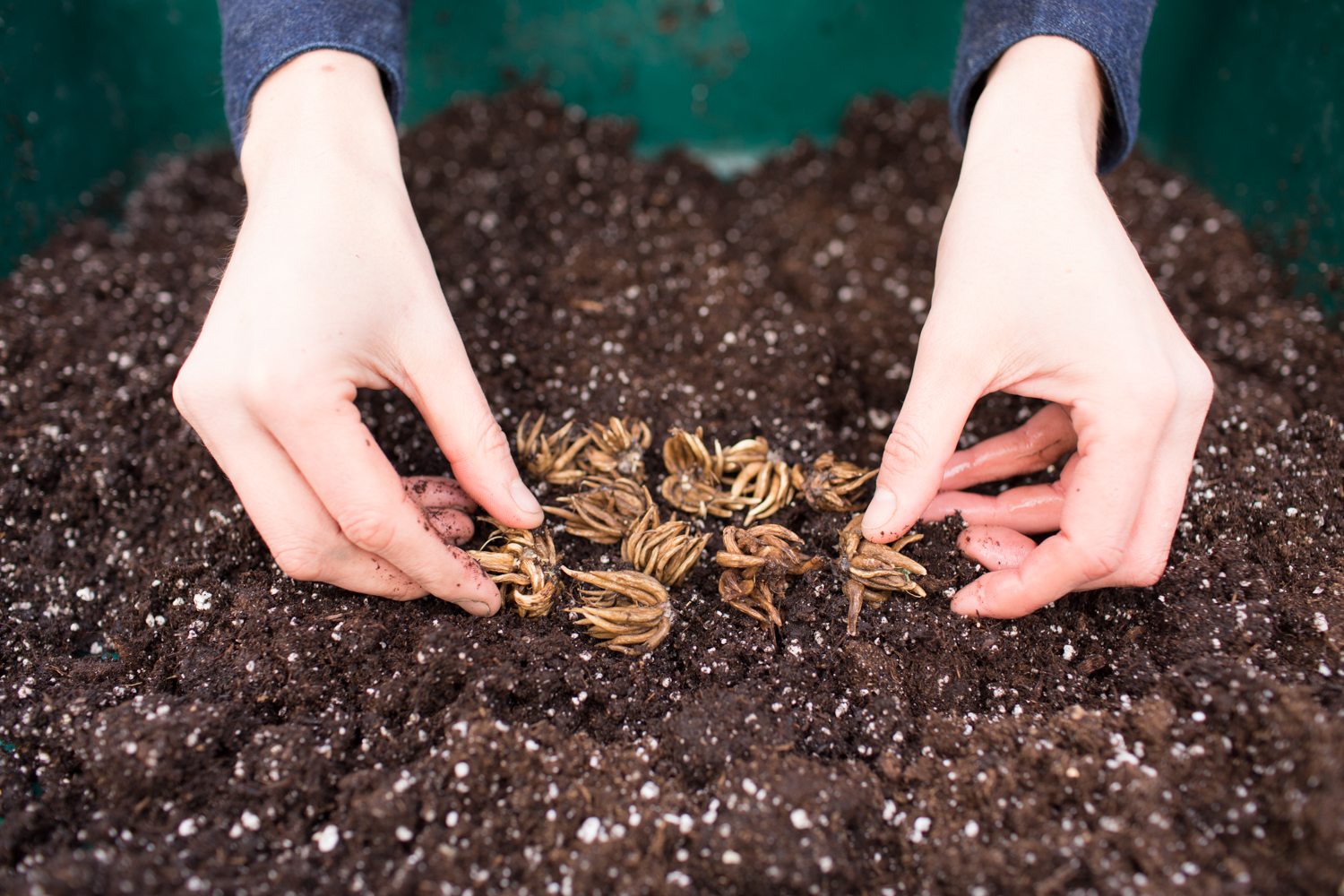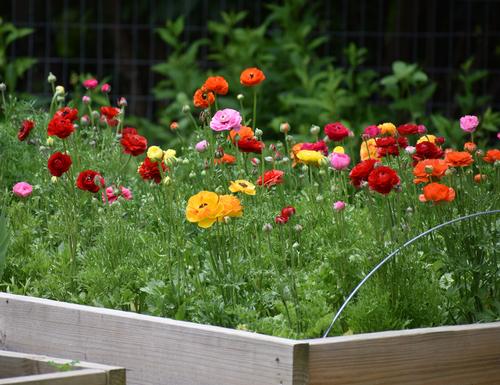How to Plant And Grow Ranunculus: Expert Tips for Stunning Blooms

Plant ranunculus corms in well-draining soil during early spring or fall. Ensure they receive full sun and moderate watering.
Ranunculus flowers, with their vibrant colors and lush petals, can enhance any garden. These perennials thrive in zones 8-10 but can be grown as annuals in cooler climates. Start by soaking the corms in water for a few hours to plump them up.
Plant the corms with the “claws” facing downwards, about 2 inches deep and 4-6 inches apart. Ranunculus requires full sun and soil that drains well to prevent rot. Water them moderately, ensuring the soil remains moist but not soggy. With proper care, you’ll enjoy a stunning display of blooms in late spring or early summer.
Choosing The Right Ranunculus Variety
Ranunculus flowers are loved for their vibrant colors and lush petals. Choosing the right variety is crucial for your garden’s success. Different varieties offer unique blooms and colors, making your garden truly special.
Popular Types
Several types of ranunculus are popular among gardeners. Knowing these can help you make an informed choice.
| Type | Description |
|---|---|
| Tecolote | Large, double blooms with a wide range of colors. |
| Picotee | White petals with colored edges, offering a striking look. |
| Butterfly | Single blooms with delicate, thin petals. |
Color Selection
Selecting the right color can elevate your garden’s beauty. Ranunculus flowers come in many shades, each adding a unique touch.
- Red: Symbolizes love and passion.
- Yellow: Represents happiness and joy.
- Pink: Stands for admiration and grace.
- White: Signifies purity and innocence.
Choose colors that match your garden’s theme. Mixing colors can create a vibrant and eye-catching display.
:strip_icc()/How-to-Plant-and-Grow-Ranunculus-1499268323-ce1a98aa558740c6988a0627a100dd25.jpg)
Preparing The Soil
To successfully plant and grow Ranunculus, preparing the soil is crucial. Healthy soil ensures robust growth and beautiful blooms. Follow these steps to create the perfect soil environment for your Ranunculus.
Soil Requirements
Ranunculus thrives in well-draining soil. They do not like waterlogged conditions. The ideal soil pH ranges from 6.0 to 7.0. This pH range ensures the best nutrient availability.
Avoid heavy clay soil. It retains too much water. Sandy or loamy soil works best. This type of soil drains well and keeps roots healthy.
Amending Soil
If your soil is too heavy, amend it. Mix organic matter into the soil. Organic matter can be compost, peat moss, or well-rotted manure. This improves soil structure and drainage.
Follow these steps to amend your soil:
- Test your soil to determine its pH and composition.
- Add compost to improve soil texture and nutrients.
- If soil is acidic, add lime to raise the pH.
- For alkaline soil, add sulfur to lower the pH.
- Mix amendments thoroughly into the top 12 inches of soil.
Here is a table summarizing soil amendments:
| Soil Type | Amendment |
|---|---|
| Clay | Compost, sand |
| Sandy | Compost, peat moss |
| Acidic | Lime |
| Alkaline | Sulfur |
After amending, ensure soil is loose and fluffy. This promotes healthy root development. A well-prepared soil bed sets the stage for beautiful Ranunculus blooms.
Planting Ranunculus
Planting ranunculus can be a rewarding experience. These flowers are vibrant and beautiful. They brighten up any garden. To get the best results, follow these steps carefully.
When To Plant
Timing is crucial for successful ranunculus planting. Plant ranunculus corms in late fall in warm climates. In cooler areas, wait until early spring. The soil should be cool, but not frozen.
Planting Depth And Spacing
Proper depth and spacing are key for healthy growth. Plant ranunculus corms about 2 inches deep. Space them 4 to 6 inches apart. This ensures they have room to grow.
Below is a table for quick reference:
| Planting Depth | Spacing |
|---|---|
| 2 inches | 4-6 inches |
Follow these steps to plant ranunculus:
- Choose a well-draining soil.
- Soak corms in water for 3-4 hours.
- Dig holes 2 inches deep.
- Place corms with the pointed end down.
- Cover with soil and water lightly.
Ranunculus loves sunlight. Ensure they get at least 6 hours of sun daily. Water them regularly, but don’t overwater. With the right care, your ranunculus will bloom beautifully.

Watering Guidelines
Proper watering is essential for healthy ranunculus plants. This guide will help you provide the right amount of water at the right times. Follow these watering guidelines to ensure your ranunculus thrives.
Initial Watering
After planting, give your ranunculus a good soak. Ensure the soil is moist but not waterlogged. Use a gentle spray or watering can to avoid disturbing the soil.
| Step | Action |
|---|---|
| 1 | Water thoroughly after planting |
| 2 | Keep soil evenly moist |
| 3 | Avoid waterlogging |
Ongoing Water Needs
Regular watering keeps ranunculus healthy. Water them deeply once a week. Increase frequency during hot or dry periods.
- Water deeply every week
- Check soil moisture regularly
- Adjust watering based on weather
Avoid overhead watering to prevent fungal issues. Use a soaker hose or drip irrigation for best results. Monitor your plants to ensure they get enough water.
Example watering schedule
- Week 1: Water deeply
- Week 2: Check soil moisture, water if needed
- Week 3: Increase watering if hot
By following these guidelines, your ranunculus will flourish. Happy gardening!
Fertilizing For Optimal Growth
To grow healthy ranunculus, proper fertilization is crucial. This process ensures vibrant blooms and robust plants. Here is a guide to help you choose and apply the right fertilizer for your ranunculus.
Choosing Fertilizer
Ranunculus needs balanced nutrients. Use a fertilizer with equal parts of nitrogen, phosphorus, and potassium. A 10-10-10 or 20-20-20 formula works well.
| Fertilizer Type | Benefits |
|---|---|
| Granular Fertilizer | Easy to apply, slow-release |
| Liquid Fertilizer | Quick absorption, immediate results |
Application Schedule
Apply fertilizer at planting time. Follow this schedule for best results:
- Initial Application: Mix granular fertilizer into the soil.
- Every Two Weeks: Use liquid fertilizer during the growing season.
- After Flowering: Reduce fertilization to once a month.
Water the plants after fertilizing. This helps the roots absorb the nutrients. Always follow the instructions on the fertilizer package.

Dealing With Pests And Diseases
Planting and growing ranunculus can be a delightful experience. Yet, pests and diseases can pose significant challenges. To ensure healthy blooms, understanding how to manage these issues is crucial.
Common Pests
Ranunculus plants are often targeted by specific pests. Here are some common pests:
- Aphids – Small, green insects that suck sap from leaves.
- Spider Mites – Tiny mites that cause yellowing and webbing on leaves.
- Thrips – Small insects that leave silvery streaks on petals.
To manage these pests, consider using natural predators. Ladybugs and predatory mites can help control aphid and spider mite populations. Neem oil is also effective against many pests.
Disease Prevention
Ranunculus plants can be susceptible to various diseases. Here are some common diseases:
| Disease | Symptoms | Prevention |
|---|---|---|
| Powdery Mildew | White, powdery spots on leaves and stems. | Avoid overhead watering. Ensure good air circulation. |
| Botrytis Blight | Gray mold on flowers and leaves. | Remove affected plants. Keep the area clean. |
| Root Rot | Yellowing leaves and stunted growth. | Ensure well-draining soil. Avoid overwatering. |
To prevent diseases, always plant ranunculus in well-draining soil. Water the base of the plants, not the leaves. Rotate your crops each year to prevent soil-borne diseases.
Pruning And Deadheading
Pruning and deadheading are essential for healthy ranunculus plants. These practices help maintain a neat appearance and boost blooming. Learn effective pruning techniques and the benefits of deadheading below.
Pruning Techniques
Effective pruning keeps your ranunculus healthy. Follow these simple steps:
- Use sharp, clean scissors to avoid plant damage.
- Remove yellow or brown leaves to prevent disease spread.
- Cut stems at an angle to promote better water absorption.
Regular pruning ensures your ranunculus grows strong and vibrant. It helps the plant focus energy on blooming.
Benefits Of Deadheading
Deadheading involves removing spent flowers. Here are the key benefits:
| Benefit | Description |
|---|---|
| Encourages new blooms | More flowers will grow when old ones are removed. |
| Prevents seed formation | Energy is redirected to growing flowers, not seeds. |
| Maintains plant appearance | Plants look neat and attractive without dead flowers. |
Deadheading is simple. Just pinch or cut off the spent flowers. This keeps your ranunculus blooming beautifully all season long.
Harvesting And Storing Blooms
Ranunculus flowers are beautiful and delicate. Proper harvesting and storing ensure their longevity. Knowing the right techniques will keep your blooms fresh and vibrant.
When To Harvest
Harvest ranunculus blooms early in the morning. The petals should be fully colored but not fully open. This stage is called the “marshmallow” stage. Gently cut the stems at an angle, about 1 inch above the base. Use clean, sharp scissors or garden shears to avoid damaging the plant.
| Time of Day | Stage of Bloom | Tools Needed |
|---|---|---|
| Early Morning | Marshmallow Stage | Clean, Sharp Scissors or Shears |
Storing Cut Flowers
Keep your cut ranunculus blooms in fresh water. Change the water every two days. Trim the stems slightly each time you change the water. This helps the flowers absorb water better.
- Use a clean vase
- Add floral preservative to the water
- Keep the vase in a cool, shaded area
Store the blooms in a cool room, away from direct sunlight. Avoid placing them near fruits. Fruits release ethylene gas, which can shorten the life of your flowers.
- Change water every two days
- Trim stems slightly each time
- Keep away from fruits
Frequently Asked Questions
What Is The Best Time To Plant Ranunculus?
The best time to plant ranunculus is in the fall. Planting in cooler months ensures they bloom in spring.
How Deep Should I Plant Ranunculus Bulbs?
Plant ranunculus bulbs about 2 inches deep in well-drained soil. This depth helps protect the bulbs from frost.
How Often Should I Water Ranunculus?
Water ranunculus once a week, ensuring soil remains moist but not soggy. Overwatering can cause root rot.
What Type Of Soil Is Ideal For Ranunculus?
Ranunculus thrive in well-drained, sandy or loamy soil. Good drainage prevents waterlogging, which can damage the bulbs.
Conclusion
Planting and growing ranunculus can be a rewarding experience. Follow the steps for healthy blooms and vibrant colors. Proper care and attention ensure your garden thrives. Enjoy the beauty and charm ranunculus bring to your outdoor space. Start your gardening journey with these stunning flowers today.
Happy planting!







One thought on “How to Plant And Grow Ranunculus: Expert Tips for Stunning Blooms”